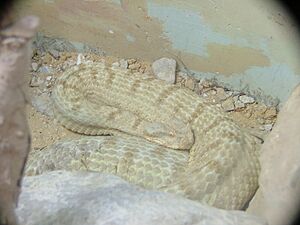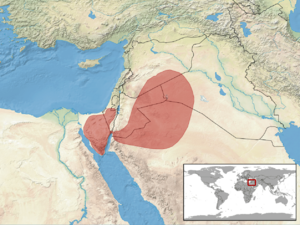Field's horned viper facts for kids
Field's horned viper (Pseudocerastes fieldi) is a special type of snake that lives in the deserts of the Middle East. It belongs to the Viperidae family, which means it's a kind of viper. Like all vipers, it has venom. This snake is known for the small, horn-like scales above its eyes. It used to be considered a subspecies of the Persian horned viper, but scientists now recognize it as its own distinct species. The main differences between Field's horned viper and the Persian horned viper are in their scales and the makeup of their venom.
Quick facts for kids Field's horned viper |
|
|---|---|
 |
|
| Field's horned viper in captivity | |
| Conservation status | |
| Scientific classification | |
| Genus: |
Pseudocerastes
|
| Species: |
fieldi
|
 |
|
| Synonyms | |
|
|
Contents
Snake Names and History
Scientists used to think Field's horned viper was just a type of Persian horned viper. But now, most experts agree it's a completely separate species. A study in 2014 looked at the genes of these snakes. It showed that Field's horned viper is as different from the Persian horned viper as it is from another snake called P. urarachnoides. This genetic evidence helped confirm it's a unique species.
The second part of the snake's scientific name, fieldi, honors an American scientist named Henry Field. He was an anthropologist, which means he studied human cultures. Henry Field was the one who first collected the specific snake specimen that was used to describe this new species. This first specimen is called the holotype. The famous Field Museum of Natural History in Chicago is named after Henry Field's grandfather, Marshall Field. The scientific paper that first described this viper was published in a journal called Fieldiana, which is also named after the Field family.
How to Spot This Snake
Field's horned viper looks a lot like the Persian horned viper, but there are some key differences, especially in their scales. Scientists count these scales to tell them apart.
Here are some ways Field's horned viper is different:
- It has fewer scales between its nose and mouth area.
- It has fewer rows of scales around the middle of its body.
- It has fewer scales on its belly.
- It has fewer scales under its tail.
| Scale Type | P. fieldi (Field's) | P. persicus (Persian) |
|---|---|---|
| Scales between nose and mouth | 1 | 2 |
| Dorsal scale rows (midbody) | 21–23 | 23–25 |
| Ventral scales (belly) | 127–142 | 144–158 |
| Subcaudal scales (under tail) | 34–46 | 38–48 |
Another difference is that Field's horned viper has a much shorter tail compared to its body length. Also, while the Persian horned viper has rough, ridged scales all over its back and sides, Field's horned viper has some rows of scales on its sides that are almost smooth.
Where They Live
Field's horned vipers are found in several countries in the Middle East. They live in the Sinai Peninsula, which is part of Egypt. You can also find them in Israel, Jordan, and the northern parts of Saudi Arabia. They are also present in northwestern Iraq and possibly in southern Syria.
The first snake specimen used to describe this species was found in a place called "Bair Wells" in what was then called Transjordania, which is now Jordan.
Their Home
These snakes prefer to live in deserts and shrublands. They can be found at different elevations, sometimes as high as 1,300 m (4,300 ft) above sea level. While they mostly stick to wild areas, they have also been seen in agricultural areas, like farms. However, they usually avoid living in or around human houses.
Reproduction
Field's horned viper is an oviparous snake. This means that the female snake lays eggs, and the baby snakes hatch from these eggs.
Venom and Safety
There's a big difference in the venom between Field's horned viper and the Persian horned viper. The Persian horned viper's venom mainly causes bleeding and tissue damage, which is common for many vipers.
However, Field's horned viper's venom is quite unusual. It contains special parts that can affect the nervous system. This is called neurotoxic activity. This means its venom can impact nerves, which is different from just causing bleeding.
Currently, there isn't a specific antivenin available for bites from either Field's horned viper or the Persian horned viper. Some general antivenoms might help with the bleeding effects, but they don't protect against the neurotoxic effects of Field's horned viper venom.


